There aren’t many scenes more cheerful than miniature daffodils blooming across the landscape. For that reason, gardeners fall in love with these charming beauties over and over again. So let’s dive into the world of these dainty bulb flowers and discover 12 types of miniature daffodils that gardeners love to grow.

But first, let’s scroll through some quick info about what defines a miniature daffodil. And we’ll take a quick peek at the official way all daffodils are classified.

Miniature daffodils are also called dwarf daffodils.
©Marinesea/Shutterstock.com
What Are Miniature Daffodils?
Miniature daffodils go by a few different names, but they’re all small plants that usually reach under 1 foot tall. Though some cultivars get a bit taller than that, most of them produce flowers under 2 inches wide.
In addition to the common name of miniature daffodils, these plants are also called dwarf daffodils or miniature narcissi. The word narcissi is the plural form of Narcissus, the genus to which all daffodils belong.
However, the miniature daffodil is not one of the official 13 daffodil divisions used to classify these plants. So the miniature daffodils belong to different divisions, depending on their characteristics.
For more information about daffodil divisions, keep reading below! And we’ll also provide the division information for each of the miniature daffodil cultivars in their individual listings.
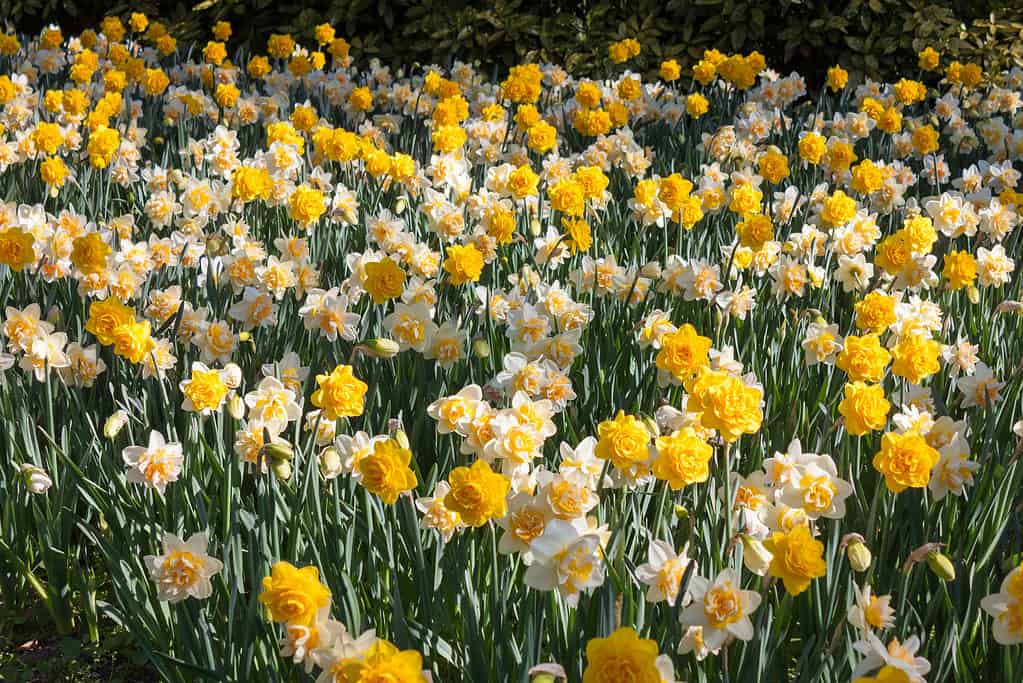
Double daffodils have their own division of unique characteristics.
©ErreCh/Shutterstock.com
What Are Daffodil Divisions?
Divisions refer to the classification of daffodils according to the shape, size, and structure of their flowers. Growers and gardening organizations use these divisions to identify plants and classify new cultivars.
Do your mini daffs tip toward the ground? Are their cups trumpet-shaped? Do they have reflexed petals? Knowing these characteristics and more will help you identify which miniature daffodil is which.
Before you read through the daffodil divisions below, here are a few flower terms you should know:
- Corona = flower cups
- Perianth segments = flower petals
- Pedicel = flower stem and sometimes called the neck of the flower
- Anthers = a flower’s pollen-producing male organs
- Whorl = a ray-like positioning of flower parts from one point on the plant

Daffodils like this small-cupped variety are identified via 13 daffodil divisions.
©Sergey V Kalyakin/Shutterstock.com
The 13 Daffodil Divisions and Their Characteristics
If you wonder which daffodil divisions your miniature daffodils fall into, this handy list will help. You can identify daffodils by their petals, cups, and the way their blooms are positioned on the stems.
Trumpet Daffodils (Division #1)
- Flowers – One bloom per stem
- Cup (Corona) – Trumpet-shaped cups that are either equal in length or longer than the petals
Large-Cupped Daffodils (Division #2)
- Flowers – One bloom per stem
- Cup (Corona) – More than one-third the length of the flower petals but not as long
Small-Cupped Daffodils (Division #3)
- Flowers – One bloom per stem
- Cup (Corona) – One-third or less than the length of the flower petals
Double Daffodils (Division #4)
- Flowers – One or more blooms per stem
- Cups/Petals – Double the petals or double the cups or both
Triandrus Daffodils (Division #5)
- Flowers – Two or more tipped (pendant) flowers per stem
- Petals (Perianth Segments) – The petals are reflexed (inverted)
Cyclamineus Daffodils (Division #6)
- Flowers – One bloom per stem
- Petals (Perianth Segments) – Considerably reflexed flower petals
- Flower Position – Flowers have a shortened neck (pedicel) and nod from an acute angle
Jonquilla Daffodils (Division #7)
- Flowers – Usually produces 1-5 blooms (or as many as eight) per stem
- Cup (Corona) – Either has flared cups, or they are funnel-shaped or cup-shaped
- Petals (Perianth Segments) – The petals are reflexed or spreading
- Flower Size – Jonquil flowers are usually wider than their length
- Scented? – Typically very fragrant
Tazetta Daffodils (Division #8)
- Flowers – 3-10 flowers grow for each of their stout stems
- Petals (Perianth Segments) – The petals are spreading but not reflexed
- Scented? – Typically very fragrant
Poeticus Daffodils (Division #9)
- Cup (Corona) – First, the flower cups are quite short or disc-shaped. Second, they have two recognizably different anther lengths. Third, the cups have a green or yellow center, a reddish edge, and possibly additional colors. Finally, the cup grows one-fifth the length of the petals or less.
- Petals (Perianth Segments) – All white
- Scented? – Typically very fragrant
Bulbocodium Hybrids (Division #10)
- Flowers – Usually have one bloom per stem
- Cup (Corona) – The cups are more dominant and noticeable compared to the petals
- Filament and Anthers – The anthers are dorsifixed, meaning they attach close to the filament center. Plus, the filament is curved.
Split-Cupped Collar Daffodils (Division #11a)
- Cup (Corona) – The cups are split into segments positioned opposite of the petal position and usually in two whorls of three.
Split-Cupped Papillion Daffodils (Division #11b)
- Cup (Corona) – The cups are split and have segments that alternate with the placement of the petals. They are also usually positioned in one whorl of six.
Other Daffodil Cultivars (Division #12)
- This division is where the daffodils not classified in the previous divisions belong. Many of them are inter-division hybrids.
Daffodils Distinguished by Botanical Name (Division #13)
- This division is for natural daffodils, wild hybrids, and wild variants.
Now that you know the daffodil divisions, let’s check out our list of 12 types of miniature daffodils!
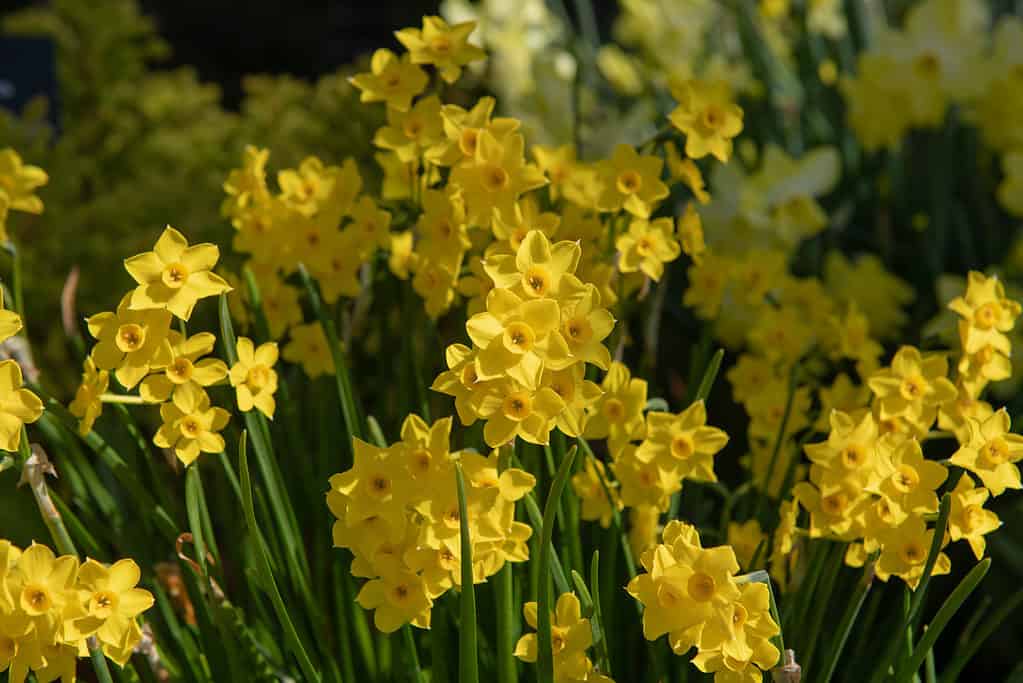
The ‘Baby Boomer’ miniature daffodils have a sweet scent and bright yellow flowers.
©Peter Turner Photography/Shutterstock.com
1. Narcissus ‘Baby Boomer’
Botanical Name: Narcissus ‘Baby Boomer’
Common Names: ‘Baby Boomer’ Jonquil, ‘Baby Boomer’ Daffodil, Miniature ‘Baby Boomer’ Daffodil
Hardiness Zones: 4-9
Flowering Season: Mid-Spring
Daffodil Type: Jonquilla – Division #7
Bloom Scent: Very sweet scent
Flower Color: Lemony petals with golden cups
Miniature ‘Baby Boomer’ daffodils have pretty 2-inch yellow flowers on plants that grow about 1 foot tall. This type of miniature daffodil has yellow petals the shade of lemons with darker yellow cups. In addition, ‘Baby Boomer’ daffodils are jonquils that bloom with an average of 1-5 flowers on each of their stems.

‘Canaliculatus’ miniature daffodils have bicolor blooms.
©Graeme L Scott/Shutterstock.com
2. Narcissus ‘Canaliculatus’
Botanical Name: Narcissus ‘Canaliculatus’
Common Names: ‘Canaliculatus’ Daffodil, Tazetta Daffodil ‘Canaliculatus,’
Hardiness Zones: 6-10
Flowering Season: Mid-Spring
Daffodil Type: Tazetta – Division #8
Bloom Scent: Subtle floral perfume
Flower Color: White petals with a yellow cup
‘Canaliculatus’ is a tazetta cultivar with lovely bicolor flowers of white and yellow. It’s also a type of miniature daffodil that prefers the warmer weather provided by Zones 6-10. And that’s no surprise since many tazetta daffodils prefer warm climates over those with freezing winters.
Uncommon for this type of daffodil, the ‘Canaliculatus’ has petals that are slightly reflexed. So that’s a unique feature of this plant compared to many other bicolor tazettas.
The ‘Canaliculatus’ daffodil produces flowers in the middle of spring with clusters of 4-8 blooms on each stem. And though this plant grows only up to 6 inches tall, its many flowers create a gorgeous sight. For that reason, planting these and other miniature daffodils in large groups creates quite a show in spring.
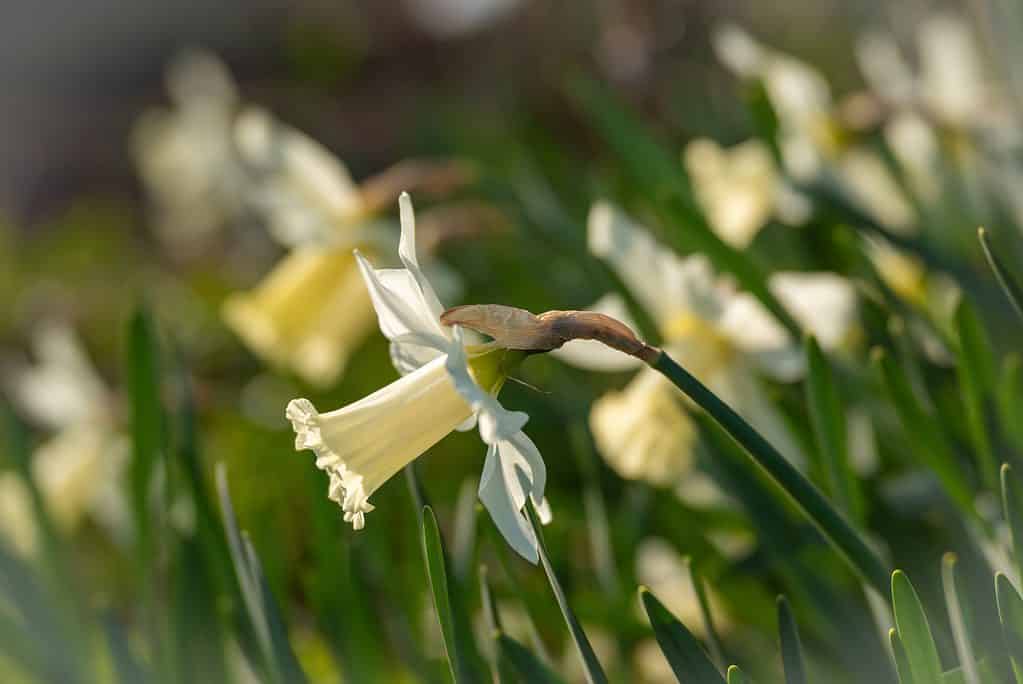
The ‘Elka’ daffodil is a miniature trumpet variety with long frilly cups.
©FLORESPHOTOGRAPHIC/Shutterstock.com
3. Narcissus ‘Elka’
Botanical Name: Narcissus ‘Elka’
Common Names: ‘Elka’ Daffodil, Trumpet ‘Elka,’ Miniature Trumpet ‘Elka’
Hardiness Zones: 3-7
Flowering Season: Early Spring
Daffodil Type: Trumpet – Division #1
Bloom Scent: Light and sweet
Flower Color: White petals and a yellow cup that fades to ivory
Miniature ‘Elka’ daffodils are small plants with a star-shaped set of petals below deep trumpet cups. ‘Elka’ flowers are mainly white, though their cups mature from pale yellow to ivory.
‘Elka’ matures at 6-8 inches tall and usually provides one flower on each stem. In addition, ‘Elka’ white daffodils are winners of the Award of Merit from the UK’s prestigious Royal Horticultural Society.
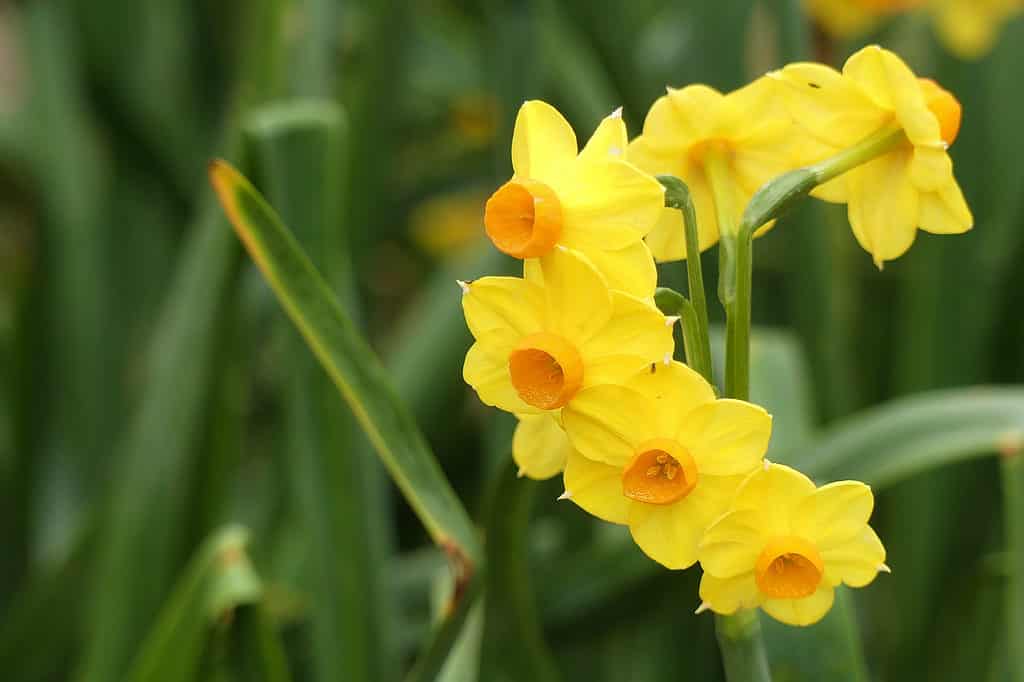
Bright and sunny ‘Grand Soleil d’Or’ miniature daffodils produce flowers by mid-spring.
©fernandoul/Shutterstock.com
4. Narcissus ‘Grand Soleil d’Or’
Botanical Name: Narcissus ‘Grand Soleil d’Or’
Common Names: ‘Grand Soleil d’Or’ Daffodil, Tazetta Daffodil ‘Grand Soleil d’Or,’
Hardiness Zones: 8-11
Flowering Season: Early or Mid-Spring
Daffodil Type: Tazetta – Division #8
Bloom Scent: Noticeably sweet
Flower Color: Pale yellow petals with light orange cups
The ‘Grand Soleil d’Or’ miniature daffodil is a bicolor tazetta variety with pale yellow petals and soft orange cups. This mini spring plant has a noticeably sweet smell. And it has a vibrant presence with 10-20 blossoms per stem! In addition, ‘Grand Soleil d’Or’ is a warm climate daffodil that grows best in Zone 8-11.
This type of miniature daffodil gets a bit taller than most since it can grow between 1-2 feet. Even so, its average high is about 12 inches.
Award-winning ‘Grand Soleil d’Or’ earned the Wister Award presented by the American Daffodil Society. Also, this daffodil took home the Royal Horticultural Society’s honored Award of Garden Merit.
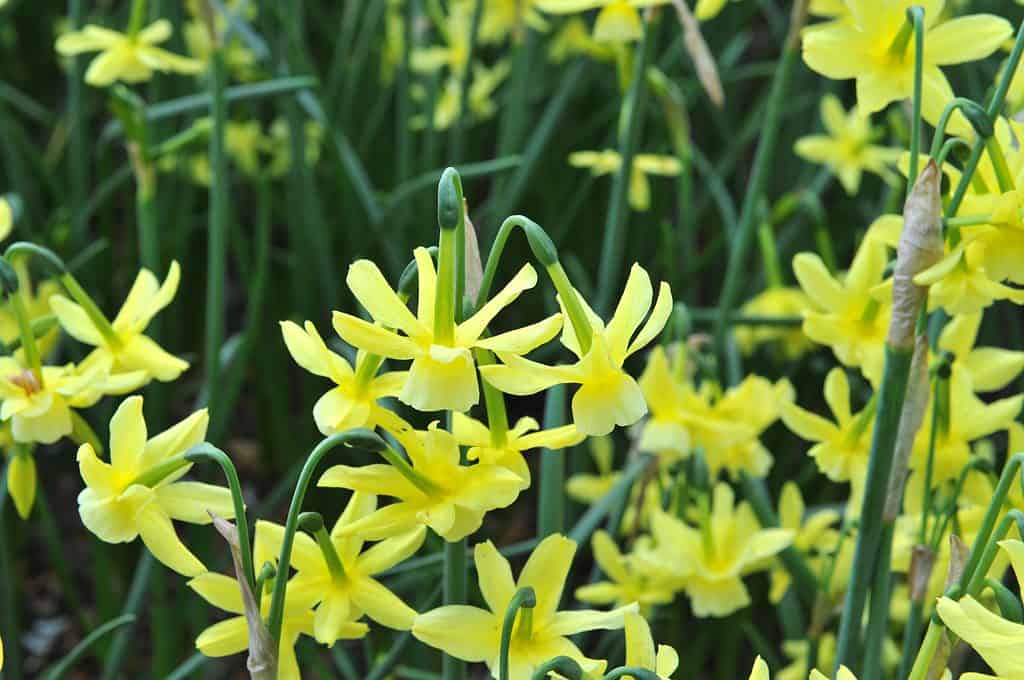
‘Hawera’ miniature daffodils have yellow blooms and smell like fresh fruit.
©Sergey V Kalyakin/Shutterstock.com
5. Narcissus ‘Hawera’
Botanical Name: Narcissus ‘Hawera’
Common Names: ‘Hawera’ Triandrus Daffodi, ‘Hawera’ Daffodil
Hardiness Zones: 3-9
Flowering Season: Mid or Late Spring
Daffodil Type: Triandrus – Division #5
Bloom Scent: Mild, fruity scent
Flower Color: Yellow petals with yellow cups
‘Hawera’ yellow daffodils have nodding flowers with slightly reflexed cups. As a triandrus daffodil, ‘Hawera’ usually produces many blooms – up to 8 per plant stem. In addition, this type of miniature daffodil performs better when planted in soil with high acidity.
The ‘Hawera’ mini daffodil grows 6-8 inches high and has a wonderfully fruity scent. It’s also an award-winning triandrus daffodil, having earned the following accolades:
- The American Daffodil Society – Wister Award
- The Royal Horticultural Society – Award of Garden Merit
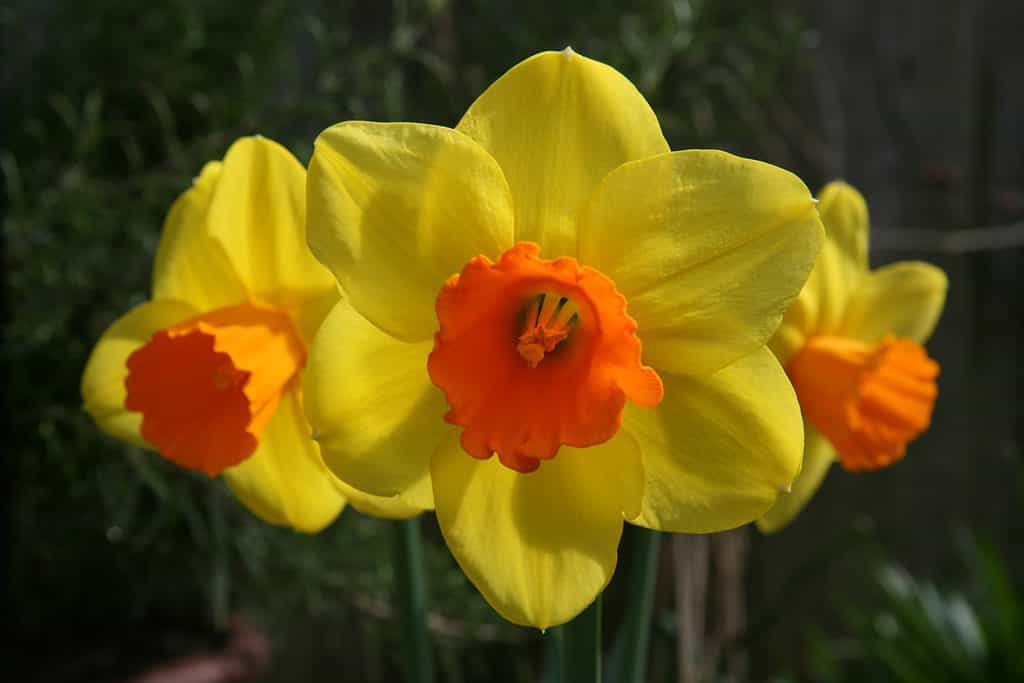
‘Jetfire’ daffodils really stand out with their canary yellow petals and bright orange cups.
©Wirestock Creators/Shutterstock.com
6. Narcissus ‘Jetfire’
Botanical Name: Narcissus ‘Jetfire’
Common Names: ‘Jetfire’ Daffodil, Cyclamineus ‘Jetfire,’ Daffodil ‘Jet Fire’ Daffodil,
Hardiness Zones: 3-9
Flowering Season: Early or Mid-Spring
Daffodil Type: Cyclamineus – Division #6
Bloom Scent: Has a light floral scent
Flower Color: Canary yellow petals behind orange cups
‘Jetfire’ is a bicolor daffodil with bright yellow petals behind beautiful orange cups. In addition, this cyclamineus type of daffodil has tipped flowers with reflected petals. And this daffodil’s extended cups have ruffled edges, adding to its standout beauty.
The ‘Jetfire’ daffodil cultivar grows around 8-10 inches at maturity and produces 3-inch flowers.
You don’t have to trust us about this daffodil’s great performance and style because it’s an award-winner. ‘Jetfire’ earned the Award of Garden Merit (AGM) from the esteemed Royal Horticultural Society.
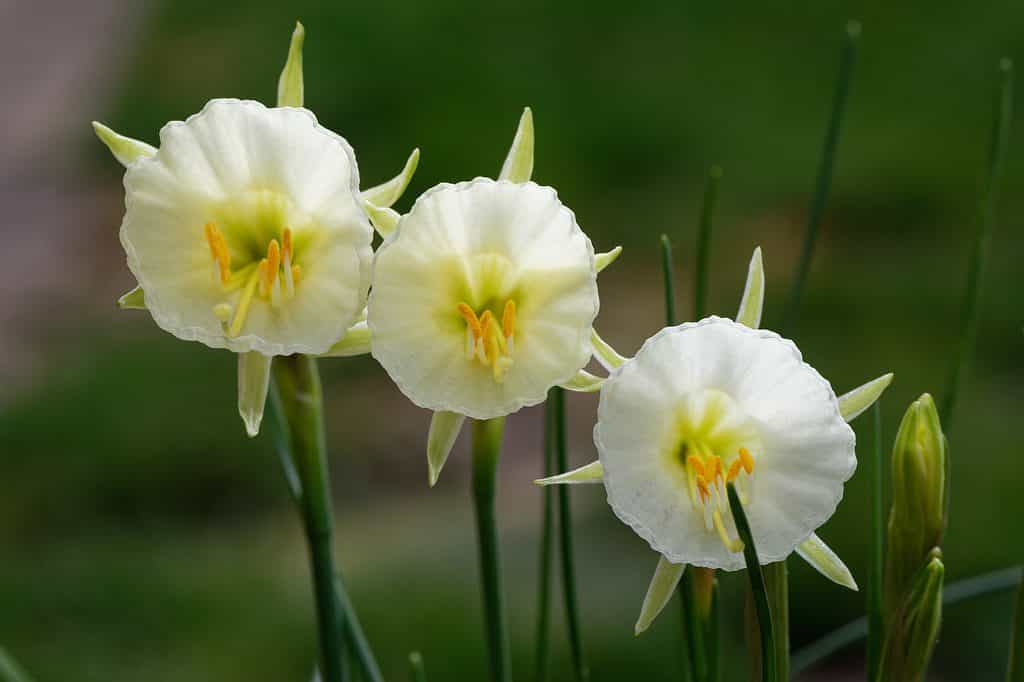
The ‘Mary Poppins’ daffodil is a bulbocodium variety with unique dominant cups.
©Walter Erhardt/Shutterstock.com
7. Narcissus ‘Mary Poppins’
Botanical Name: Narcissus ‘Mary Poppins’
Common Names: ‘Mary Poppins’ Daffodil, Bulbocodium ‘Mary Poppins’ Daffodil, Hoop Petticoat
Hardiness Zones: 5-7
Flowering Season: Early or Mid-Spring
Daffodil Type: Bulbocodium Hybrid – Division #10
Bloom Scent: Delicate scent
Flower Color: Ivory petals with yellow cups
The ‘Mary Poppins’ miniature daffodil is a fascinating cultivar on our list. This bulb flower belongs to the bulbocodium division and has a unique look. For example, ‘Mary Poppins’ flowers have huge cups and barely-there petals that are very thin. In addition to having a special style, these flowers start pale yellow and soon mature to white.
Due to the shape of its blooms, ‘Mary Poppins’ is also a type of miniature daffodil called a Hoop Petticoat. This variety grows 10-11 inches tall and produces flowers in early spring.
As a bulbocodium daffodil, your ‘Mary Poppins’ plants will probably have one flower per stem. But plant a bunch of them together in drifts and watch them show off their pretty hoops for weeks!
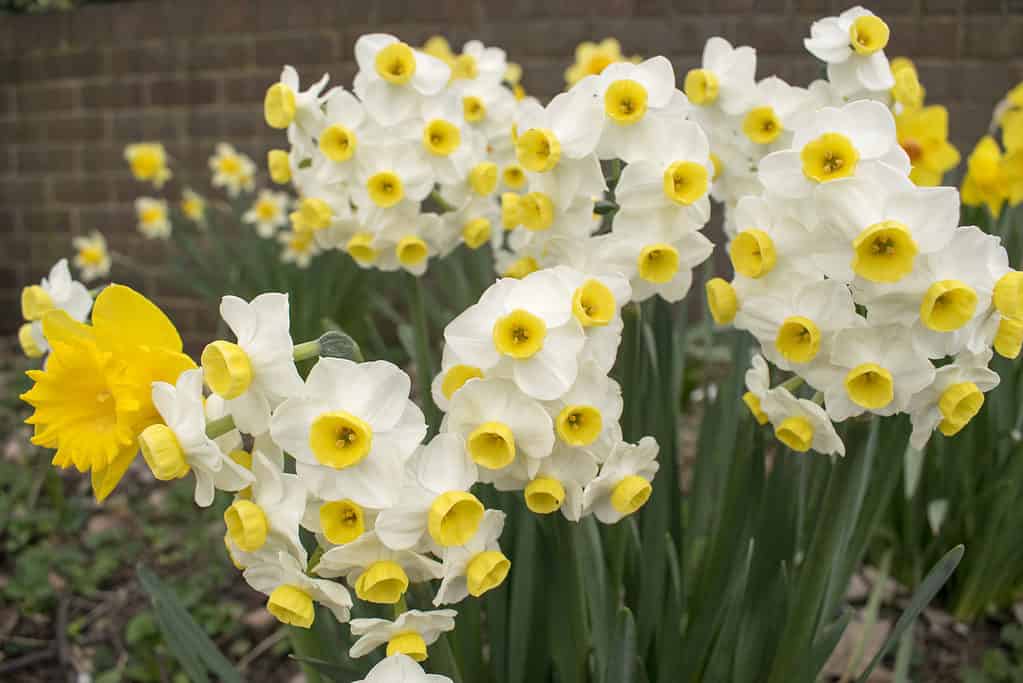
Clusters of bicolor ‘Minnow’ miniature daffodils are a cheery sight.
©iStock.com/Des Green
8. Narcissus ‘Minnow’
Botanical Name: Narcissus ‘Minnow’
Common Names: ‘Minnow’ Daffodil, Tazetta Daffodil ‘Minnow,’
Hardiness Zones: 5-9
Flowering Season: Mid-Spring
Daffodil Type: Tazetta – Division #8
Bloom Scent: Pleasingly sweet
Flower Color: Pale yellow (nearly cream) petals and golden yellow cups
‘Minnow’ is a sturdy tazetta daffodil with two-tone yellow flowers and frilly cups. Additionally, its cups mature from yellow to cream on 8-inch tall plants.
This type of miniature daffodil thrives in Zones 5-9 and will win you over with its incredibly sweet fragrance. And, though small, this strong and long-lasting plant makes an excellent daffodil for cut flower gardens. Plus, it will provide 3-5 flowers per stem.
‘Minnow’ is such an outstanding daffodil it got the attention of the Royal Horticultural Society and received its Award of Garden Merit.
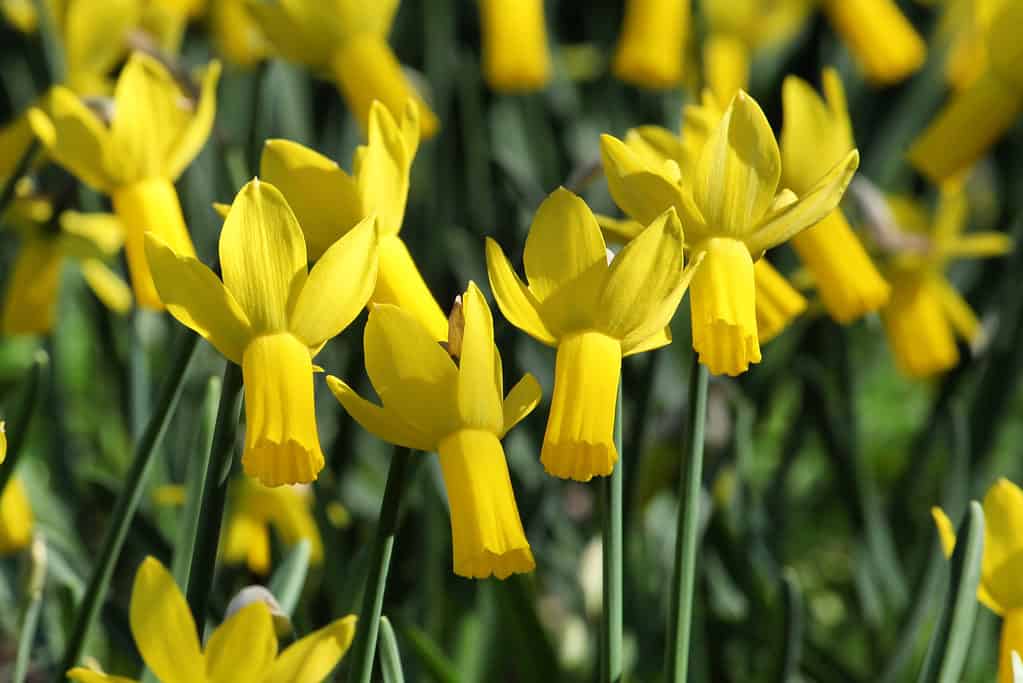
The ‘Rapture’ cultivar is a nodding miniature daffodil with reflexed petals.
©Alex Manders/Shutterstock.com
9. Narcissus ‘Rapture’
Botanical Name: Narcissus ‘Rapture’
Common Names: ‘Rapture’ Daffodil, Cyclamineus Daffodil ‘Rapture,’
Hardiness Zones: 3-7
Flowering Season: Early Spring
Daffodil Type: Cyclamineus – Division #6
Bloom Scent: Light scent
Flower Color: Yellow petals and cups
With its tightly inverted petals and long trumpet cup, the tipped ‘Rapture’ daffodil looks like a rocket aiming for the soil. As a result, this bright yellow cyclamineus daffodil is a stunning plant for gardens in Zones 3-7. Fortunately, ‘Rapture’ blooms early in spring for those needing a sign that the world is coming back to life at winter’s end.
‘Rapture’ miniature daffodils grow 12-14 inches high and usually provide one 3-inch flower per stem. And its flowers are long-lasting, which might stay lovely until mid-season.
Not only do its rocket-shaped flowers mesmerize gardeners, but they dazzle at award time too. ‘Rapture’ earned many garden flower awards, including the RHS Award of Garden Merit. Plus, it won the William G. Pannill Award from the American Daffodil Society for outstanding American hybrid daffodils.

Highly scented ‘Sailboat’ daffodils bloom in mid-spring.
©Alex Manders/Shutterstock.com
10. Narcissus ‘Sailboat’
Botanical Name: Narcissus ‘Sailboat’
Common Names: ‘Sailboat’ Daffodil, ‘Sailboat’ Jonquil
Hardiness Zones: 3-9
Flowering Season: Mid-Spring
Daffodil Type: Jonquilla – Division #7
Bloom Scent: Robust, sweet scent
Flower Color: White petals with a light yellow cup
‘Sailboat’ miniature daffodils are jonquilla varieties with white petals and soft yellow cups. Jonquils like ‘Sailboat’ have a strong, heavenly scent wafting up from their 2 1/2-inch flowers. Also, with their slightly reflexed petals swept back, these daffodils really do seem to set sail.
Miniature ‘Sailboat’ jonquils reach an average of 12 inches in height. And their graceful movement and soft hues make these daffodils a lovely sight in any garden. They’re ultra-fragrant too.
‘Sailboat’ daffodils are very deserving winners of the Royal Horticultural Society’s Award of Garden Merit.

‘Sun Disc’ miniature daffodils are yellow jonquils that grow best in Zones 3-8.
©Peter Turner Photography/Shutterstock.com
11. Narcissus ‘Sun Disc’
Botanical Name: Narcissus ‘Sun Disc’
Common Names: ‘Sun Disc’ Daffodil, ‘Sun Disc’ Jonquil,
Hardiness Zones: 3-8
Flowering Season: Mid or Late Spring
Daffodil Type: Jonquilla – Division #7
Bloom Scent: Very sweet floral perfume
Flower Color: Pale yellow petals with golden yellow cups
‘Sun Disc’ miniature daffodils bloom in late spring and lure you to the garden with their delightful scent. These jonquilla daffodils feature pale yellow petals with dark yellow disc-shaped cups.
The ‘Sun Disc’ daffodil grows 10-12 inches tall and performs the best in Zones 3-8. It also impressed the Royal Horticultural Society and received the high honor of the Award of Garden Merit.

‘Tete-a-Tete’ miniature daffodils belong in the cyclamineus division.
©Helen J Davies/Shutterstock.com
12. Narcissus ‘Tete-a-Tete’
Botanical Name: Narcissus ‘Tete-a-Tete’
Common Names: ‘Tete-a-Tete’ Daffodil, Dwarf Daffodil
Hardiness Zones: 3-9
Flowering Season: Early or Mid Spring
Daffodil Type: Cyclamineus – Division #6
Bloom Scent: Highly fragrant
Flower Color: Bright yellow petals with egg yolk cups
‘Tete-a-Tete’ is a type of miniature daffodil that blooms early to mid-spring. The ‘Tete-a-Tete’ grows 6-8 inches tall and usually provides an abundance of 2-3 inch flowers. Also, it’s a cyclamineus daffodil with lightly reflexed petals on nodding blooms.
With its sunny yellow petals and egg yolk cups, ‘Tete-a-Tete’ is a very popular miniature daffodil for home gardens. Additionally, this cultivar is easy to naturalize and grow indoors by forcing the bulbs.
It’s fitting to close our list of miniature daffodils with another award winner for your consideration. So, here are two major awards earned by ‘Tete-a-Tete’ that will be no surprise to daffodil growers and fans:
- The Wister Award – The American Daffodil Society
- The Award of Merit – The Royal Horticultural Society
Cheerful Miniature Daffodils Provide Lots of Charm
By now, it’s obvious why miniature daffodils bring charm and cheer to gardens in the spring. Their sweet scents paired with quaint and pretty flowers always bring a smile. And each variety has its own unique characteristics, from cheery all-yellow shine to charming bicolor beauty. But, above all, these charming little plants become majestic drifts of flowers when planted en masse. So plant miniature daffodils in droves and enjoy the smiles they bring!
The photo featured at the top of this post is © StephenVanHove/Shutterstock.com
Thank you for reading! Have some feedback for us? Contact the AZ Animals editorial team.






